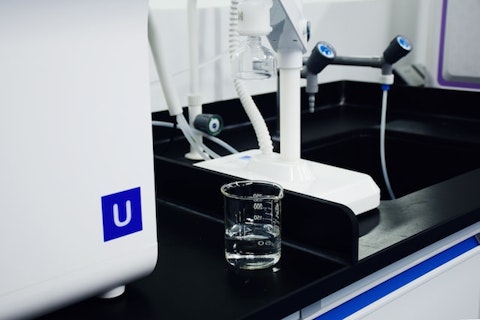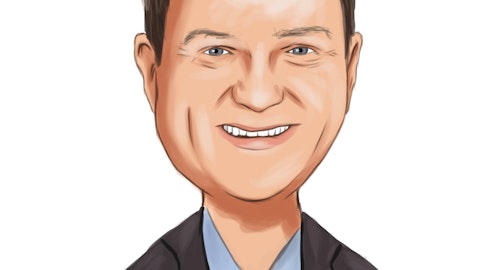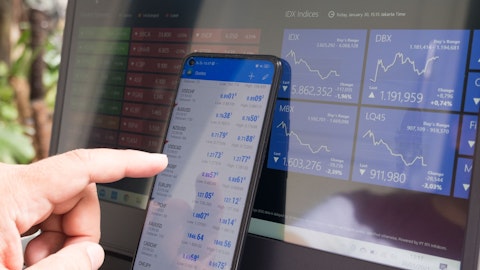Xylem Inc. (NYSE:XYL) Q4 2022 Earnings Call Transcript February 7, 2023
Operator: Welcome to Xylem’s Fourth Quarter and Full Year 2022 Earnings Conference Call. . I would now like to turn the call over to Andrea van der Berg, Vice President of Investor Relations.
Andrea van der Berg: Thank you, operator. Good morning, everyone, and welcome to Xylem’s Fourth Quarter and Full Year 2022 Earnings Call. With me today are Chief Executive Officer, Patrick Decker; Chief Financial Officer, Sandy Rowland; and Chief Operating Officer, Matthew Pine. They will provide their perspective on Xylem’s fourth quarter and full year 2022 results and discuss our outlook and guidance for 2023. Following our prepared remarks, we will address questions related to the information covered on the call. As a reminder, this call and our webcast are accompanied by a slide presentation available in the Investors section of our website, www.xylem.com. A replay of today’s call will be available until midnight, February 14.
Please note the replay number +1 (800) 388-6509 or +1 (402) 220-1111. Additionally, the call will be available for playback via the Investors section of our website under the heading Investor Events. Please turn to Slide 2. We’ll make some forward-looking statements on today’s call, including references to future events or developments that we anticipate will or may occur in the future. These statements are subject to future risks and uncertainties, such as those factors described in Xylem’s most recent annual report on Form 10-K and subsequent reports filed with the SEC. Please note that the company undertakes no obligation to update any forward-looking statements publicly to reflect subsequent events or circumstances, and actual events or results could differ materially from those anticipated.
Please turn to Slide 3. We have provided you with a summary of our key performance metrics, including both GAAP and non-GAAP metrics. For purposes of today’s call, all references will be on an organic and adjusted basis, unless otherwise indicated. And non-GAAP financials have been reconciled for you and are included in the Appendix section of the presentation. Now please turn to Slide 4, and I’ll turn the call over to our CEO, Patrick Decker.
Patrick Decker: Thanks, Andrea, and good morning, everyone. As we indicated in our press release, the team delivered a very strong operational performance in the fourth quarter, exceeding our expectations across each segment and region. Resilient demand and strong backlog execution delivered 20% revenue growth for the quarter and healthy EBITDA margin expansion. That performance continued and built upon the team’s solid delivery through the year, fueling healthy momentum coming into 2023. On a full year basis, revenue grew 11% and earnings per share grew 14%. Water Infrastructure grew 15% in the quarter on robust utilities and industrial demand in the U.S. and Western Europe, and the segment was up 12% for the full year. M&CS posted very strong fourth quarter performance.
This segment was up 35% in the quarter on backlog execution from improved chip supply and continued strong demand, bringing full year growth to 8%. Applied Water grew 17% in the quarter and finished 2022 with 14% growth for the full year. Overall, higher volumes and positive price cost performance drove significant EBITDA margin expansion in the quarter, up 250 basis points versus the same period a year ago. The team delivered that growth and margin performance on continuing resilient demand globally. We saw healthy orders growth sequentially. And for the full year, orders were up 4%, demonstrating the durability of our business. I am so proud of the team’s performance in serving our customers and of their commitment to our purpose, solving water.
The global trends driving investment in water systems continue to intensify. And as today’s results demonstrate, we are already very strongly positioned to address them. That said, our recent agreement to acquire Evoqua announced 2 weeks ago, will create a powerful platform to address the world’s most critical water challenges with greater capability, depth and scale. We’ve begun the important work of integration planning to set the combined company up for success and are well into the process of seeking the necessary approvals. Until the deal closes, which we anticipate will be midyear, we remain focused on delivering results to the stakeholders we serve today. On that stand-alone basis, we see continuing resilient demand in our largest end markets, particularly utilities, despite the possibility of macroeconomic softness, Execution of our backlogs with ongoing price cost discipline, further supply chain improvements and a return to 100% free cash flow conversion.
We expect that this will allow us to deliver 2023 organic revenue growth in the mid-single digits with solid EBITDA margin expansion, resulting in earnings per share between $3 and $3.25, up 10% versus last year at the midpoint of the range. We’ll give more color on the outlook and guide in a moment, but first, I’ll hand it over to Sandy to dig in briefly on the quarter’s results before we look ahead at 2023.
Sandy Rowland: Thanks, Patrick. Please turn to Slide 5, and I’ll cover our fourth quarter results. As Patrick highlighted, the team closed out a strong 2022 with another quarter of robust growth and margin expansion. Revenue grew 20% year-over-year, led by 26% growth in the U.S. and mid-teen growth in Western Europe and the emerging markets. In a moment, I’ll give you a detailed performance by segment. But in short, utilities was up 24%, with strength in the U.S. driven by chip supply improvements in M&CS, and robust OpEx demand in Water Infrastructure. Industrial grew 15% on particularly strong demand in Western Europe and emerging markets and sustained strength in the U.S. Commercial was up 24%, mainly due to continued backlog execution in the U.S. and Western Europe.
And residential was up 17%, driven by strength in emerging markets, partially offset by softness in the U.S. Compared to prior year, orders were down 3% in the quarter versus up 23% in the same period last year, but underlying demand remains resilient and in line sequentially. Water Infrastructure orders were up 13%, AWS down 6% and M&CS down 19%, following exceptionally high orders last year. However, M&CS orders were in line with the last quarter with a book-to-bill ratio of 1.1x. EBITDA margin was 18.7%, up 250 basis points from the prior year and up 40 basis points sequentially on strong volume and price, which more than offset inflation. Our EPS in the quarter was $0.92, up 46% year-over-year. Please turn to Slide 6, and I’ll review the quarter’s segment performance in a bit more detail.
Water Infrastructure outperformed expectations with revenues up 15% in the quarter. Growth was robust across the portfolio, led by our wastewater utility business in the U.S. and industrial strength in emerging markets on continued dewatering demand. Geographically, the U.S. was up 26% with solid price realization on strong utilities OpEx demand and continued improvements in the supply chain. Foster Europe grew low double digits, driven by healthy industrial activity and emerging markets was also up low double digits, driven by dewatering demand in Latin America and Africa. Orders in the fourth quarter were up 13% with solid dewatering demand in emerging markets and continued utility strength in the U.S. EBITDA margin for the segment was up 80 basis points as price, net of inflation and volume conversion more than offset strategic investments.
Please turn to Page 7. The Applied Water segment also exceeded expectations with fourth quarter revenues up 17% on strong price realization and backlog execution. Geographically, Western Europe was up over 20%, led by supply chain improvements and strong industrial and commercial demand. Emerging Markets was up mid-double digits on strong residential demand in the Middle East and India. The U.S. was up low double digits as supply chain improvements and price realization were partially offset by moderating residential volumes. Orders were down 6% in the quarter, with healthy industrial demand in the U.S. and Western Europe, offset by slowing U.S. residential orders. Segment EBITDA margin was up 270 basis points in the quarter. Margin expansion was driven by continued strong price realization, more than offsetting inflation and further supplemented by productivity savings.
And now let’s turn to Slide 8, and I’ll cover our Measurement & Control Solutions business. M&CS revenue was up 35%, driven by recoveries in chip supply year-over-year and strong project execution in our test and measurement and pipeline assessment services businesses. Geographically, all regions were up more than 20%, led by U.S. growth of over 40%. M&CS orders were down 19% in the quarter, lapping a prior year compare of 28% orders growth during the peak of supply chain constraints. Demand for our AMI offering remains strong and our $2.1 billion backlog in M&CS is up 14% versus prior year. EBITDA margin for the segment was up 800 basis points versus the prior year and importantly, 130 basis points quarter sequentially. Strong volume conversion, coupled with price realization offsetting inflation, drove the expansion.
And now let’s turn to Slide 9 for an overview of cash flows and the company’s financial position. In the fourth quarter, we generated free cash flow of $302 million. The team did a great job driving down working capital to hit our previous outlook of 80% free cash flow conversion for the year. While inventory remains elevated versus where we targeted to be longer term, as there still are pockets of the supply chain that necessitate the extra safety stock that we are carrying, our performance in Q4 gives us confidence in our path to return to 100% conversion in 2023. Our financial position remains robust as we exit the year with over $900 million in cash and available liquidity of $1.7 billion. And this is after paying down over $500 million of debt in December.
Net debt-to-EBITDA leverage is 1.0x. Please turn to Slide 10, and I’ll hand back to Patrick to look forward at 2023.
Patrick Decker: Thanks, Sandy. The team did an excellent job delivering for our customers and communities in 2022. Their commitment and performance stood out during a tumultuous year of global economic and geopolitical uncertainty; lingering pandemic effects, especially in China; and a challenging supply chain environment. I’m very proud of everything the team achieved, and they are already carrying all that commercial momentum, operational discipline and resilience into 2023. As we look forward, we see continued healthy demand in our major markets despite the possibility of macroeconomic softness in certain sectors of the global economy. We expect that the essential nature of our solutions and the secular trends in water will continue to underpin demand in the attractive, stable end markets that we serve.
And we expect to be even better able to serve that demand as supply chain friction continues to ease, and we can progressively work down our $3.6 billion backlogs. Looking ahead, we are advancing our strategic delivery of solutions to the acquisition of Evoqua. As I mentioned earlier, and as you would expect, until the deal closes, we are only providing organic guidance for Xylem on a stand-alone basis. But there’s no doubt that the combination of Xylem’s global utility scale and Evoqua’s strength in attractive industrial end markets creates a powerful platform for growth. We expect significant revenue synergies in areas such as cross-selling of our respective utility and industrial portfolios in North America, and growing Evoqua’s international exposure via Xylem’s global channels and customer relationships.

Photo by RephiLe water on Unsplash
Now those are just 2 of the areas where we see tremendous potential to add to the growth of the combined companies and expand our value to customers globally, especially in a number of the most attractive water end markets. But it’s not the only inorganic move we’re making to give customers more of what they need most. We’ve also taken a big step forward in helping them adopt the digital solutions they need to increase the resilience of communities essential water infrastructure. In the shadow of our big announcement with Evoqua, another important partnership flew under the radar, one which will accelerate and enhance our ability to deliver more digital solutions to the utility customers around the world. Last quarter, we signed an exclusive commercial partnership with Idrica to make adoption of digital technologies easier, faster and more affordable for our utility customers.
Headquartered in Valentia, Spain, Idrica is a leader in data management and analytics for water utilities. Idrica’s GoAigua platform simplifies deployment and operation of new digital capabilities in any water utilities operations. It gives them one secure integrated interface that brings together data capture, analytics and asset and process management onto 1 platform. Having been born out of a utility operator itself, the platform has the advantage of having been built by utility for utilities, and it’s already been deployed by over 300 customers around the world. Under the partnership, we will take a minority stake in Idrica and become the exclusive global distributor of their technology. Together, we will enable more utilities to harness the power of connected solutions.
We’re very excited about it, and we look forward to sharing more as the partnership progresses. We made one other important announcement recently. This one was just before the end of the year, appointing Matthew Pine as Chief Operating Officer. The move ensures that we have continuing focus on operational excellence from an enterprise perspective across all our business segments and regions to continue delivering on our commitment to faster-than-market revenue growth and margin expansion. At the same time, it’s also freed up some of my capacity to deliver on Xylem’s strategic evolution and capital deployment. In a moment, we’ll turn the call back to Sandy for more detail on our guide. But first, I want to invite Matthew to say a few words on his key areas of focus in the new role and provide some color on our end market outlook.
Matthew?
Matthew Pine: Thanks, Patrick. We are very strongly positioned on intensifying trends with technology leadership in a large and growing installed base in attractive end markets. My focus as Chief Operating Officer is to further accelerate profitable growth and maximize the value we deliver to customers and communities around the world. Across the business, we continue to remove complexity, increase our local agility and unlock further scale efficiencies. This is all aimed, of course, at better serving our customers at the same time we deliver continuing margin expansion. We’re driving this margin focus across the enterprise, taking particular aim at even more enhanced productivity and customer satisfaction. For example, in the M&CS segment, improvements in chip supply enabled us to build momentum, delivering the accretive backlog, we deploy resources back to productivity as well as new product introductions from innovation.
Secondly, we continue to enhance our digital portfolio, as Patrick covered. Our customers need simple, integrated digital technologies that solve their problems cost effectively. Our portfolio increasingly meets that demand with attractive growth and margin profiles. Lastly, our customers depend on Xylem as a trusted partner to deliver ongoing support. So our third operational focus is in standardizing our solutions and creating new offerings. This will take us deeper into our installed base with aftermarket sales and services. New offerings such as outcome-based solutions and condition-based maintenance will enable us to capture demand, address customers’ needs and expand reoccurring revenues. It’s no accident that there’s a theme running through all 3 of these priorities.
Each is about growing revenues and improving our margins by serving our customers better, more thoroughly and more simply, making it even easier for them to do business with us and solve more of their challenges. When we talk about being in a privileged position, that’s not mentally to refer to our strategic or market positioning. It also reflects our view that we are fortunate to work alongside the kind of customers that we do, partner with them to solve their critical water challenges they face. It’s a privilege and also a great opportunity for continuing value creation from our shareholders, communities and all stakeholders. Now let’s turn to Slide 11, and I’ll walk you through our end market outlook. We expect underlying demand and most of our end markets will continue to be healthy through 2023.
We’ve taken a balanced view based on the strength of our backlog, critical nature of our largest end markets, and the continued value proposition of our differentiated products. We anticipate our utility business overall, which is our largest end market, will grow high single digits in 2023. On the wastewater side, we expect mid-single-digit growth as we see a continuation of steady global demand. We anticipate resilient OpEx demand in developed markets due to the critical nature of our offerings as well as the benefit of continued CapEx spend in emerging markets. The outlook for longer-term capital project spending and bid activity remains robust. On the clean water side, we anticipate revenues being up low teens. This growth is driven by continued robust demand for our AMI solutions and expected improvements in ship supply through 2023, allowing for significant large deal deployments already secured in our backlog.
We foresee healthy momentum in our test and measurement and our pipeline assessment service businesses due to increased focus on infrastructure and climate challenges. Looking at the industrial end market, we expect to go low to mid-single digits on steady demand for our solutions globally. We continue to see strong growth in dewatering due to mining demand in emerging markets and the benefits of our strategic investments in our U.S. and European dewatering business. The commercial end market should deliver low single-digit growth on solid replacement business and backlog execution, partially offset by moderation in new construction. In residential, our smallest end market, we are expecting low single-digit decline due to normalizing demand in the U.S., partially offset by continued strength in emerging markets.
In both commercial and residential, we would expect moderation to emerge in the second half results as we continue to work through the backlog in the first half of 2023. Now I’ll turn it over to Sandy to walk you through our updated guidance.
Sandy Rowland: Thank you, Matthew. Turning to Slide 12. As mentioned, we expect Evoqua to join us in mid-2023. We Until then, our full year guidance is on an organic basis and excludes the combination of the 2 companies. For Xylem overall, we foresee full year 2023 revenue growth in the range of 4% to 6%. This breaks down by segment as follows: mid-single-digit growth in Water Infrastructure with solid growth in both wastewater utilities and industrial; low single-digit growth in Applied Water from growth in industrial and commercial, partially offset by residential; We expect Measurement & Control Solutions to be up low teens. For 2023, we expect EBITDA to be in the range of 17.5% to 18%. This represents a 50 to 100 basis point margin expansion versus prior year.
And this yields an EPS range of $3 to $3.25, up 10% at the midpoint over the prior year. Free cash flow conversion is expected to be 100% of net income. In addition, today, we announced an increase in our annual dividend of 10%, aligned with our capital allocation framework to grow dividends in line with earnings. We’ve also provided you with a number of other full year assumptions in the slide to supplement your models. We’re assuming a euro-to-dollar conversion rate of 1.08 and a foreign exchange can be volatile, our FX sensitivity table is included in the appendix. And now drilling down on the first quarter, we anticipate total company revenues will be in the range of 7% to 9% growth. By segment, we expect high single-digit growth in Water Infrastructure, low single digits in Applied Water and high teens growth for M&CS.
We expect first quarter EBITDA margin to be approximately 16%, driven by higher volumes and more favorable price cost dynamics. And with that, please turn to Slide 13, and I’ll turn the call back over to Patrick for closing comments.
Patrick Decker: Thanks, Sandy. We’re coming into 2023, very strongly positioned. Our end markets continue to show resilient underlying demand. We’re confident in delivering mid-single-digit revenue growth and strong margin expansion and the team continues to outperform on strong operational and commercial execution. Beyond 2023, we remain well on track to deliver our longer-term strategic and financial milestones. We are very excited about all of the combination of Xylem and Evoqua will offer towards the creation of a more water secure, resilient and sustainable world, while driving value for our shareholders by accelerating growth and scale. The integration team met last week at our headquarters in D.C. The first of many meetings to set us up for success on day 1.
And last week, I traveled with Ron Keating, Evoqua’s CEO, to a number of their key sites to spend time with their incredibly talented people. Those visits only heighten my appreciation of the potential opportunities ahead and confirm the strong strategic and cultural fit of our 2 companies. We’ve also taken the next step in the regulatory process, having submitted the required filings here in the U.S. and progressing toward filings in the relevant international jurisdictions. We continue to anticipate the deal closing midyear A great deal of opportunity will open up when we bring our 2 companies together. During our next earnings call, we will provide an update on our progress. Meanwhile, our business remains squarely focused on delivering on our 2023 financial commitments and continuing our commercial momentum and execution.
Now operator, I’ll turn the call back over to you for questions.
See also 25 Most Famous Companies in the World and 25 Countries with the Most Billionaires.
Q&A Session
Follow Xylem Inc. (NYSE:XYL)
Follow Xylem Inc. (NYSE:XYL)
Operator: We’ll take our first question from Deane Dray with RBC Capital Markets.
Deane Dray: Strong finish to the year, both revenues and margins. And I just want to say congrats again on finally getting to the altar on Evoqua. This has made strategic sense for so long. And have a midyear target closing is lightning fast in our view. I know that there’s a lot of heavy lifting. So best of luck.
Patrick Decker: Thank you very much, Deane.
Deane Dray: Can we start with M&CS margins? It sounds like the 2 drivers here, the chip supply improving, and this has been kind of a steady story for the past couple of quarters. How much have you worked through that backlog? And how much of the chip supply improvement contributed to the margin improvement in the segment? And then I’ve seen a nice shutout for pipeline assessment. Is this all pure and what’s driving that?
Sandy Rowland: Yes, Deane, thanks for the question. Let me start, and Matt can add some color here. So we are very pleased with our Q4 performance in M&CS. The year has unfolded very much like we thought it would with continuing improvement in chip supply. The story in Q4 is actually a twofold story. We saw some upside compared to what we had forecast, and half of that upside came from some better chip supply. And the other half of the upside came from some of our other businesses in the portfolio that we don’t talk as much about. So our pipeline assessment services business, a lot of projects were completed in Q4, really good results in our test and measurement business. And all of — the entire portfolio across M&CS has good margin potential and good leverage. And so as we’ve got the top line going again, we’re really encouraged that you’re seeing that drop to the bottom line.
Matthew Pine: Yes. I think the only thing I would add, Deane, is that we did pivot in Q4 to a more continuous improvement as we started to roll off of our product redesigns. So we saw a really good lift in Q4 and continuous improvement. And if you look at the price cost and the exit rate in Q4, it was really solid building momentum. This was — if you recall, this was the last segment to really be impacted by inflation and really overcoming that in Q4, which also led to the margin improvement.
Deane Dray: All sounds good. And just as a follow-up, I was hoping to get some more color on this announcement of the software platform investment at Idrica. If you listen to all of the trade shows and conferences, the biggest pain point for utilities is they get so much data, but none of it is connected, and it’s all different formats. So this sounds really promising if it’s one platform that then is able to integrate all of this. So some color on the pricing. Is this a SaaS business? Is it on-prem? Is it licensed? How will it fit in terms of the revenue stream? And you’ve got 300 customers now. What’s the pipeline for new customers, new logos?





